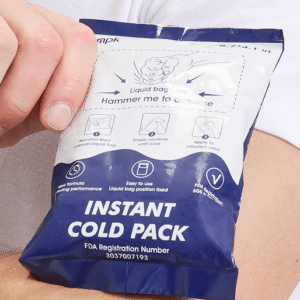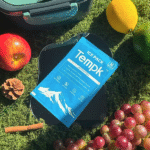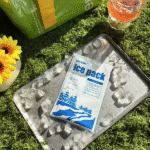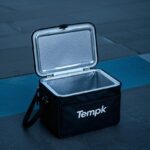Cold Chain Logistics Monitoring: How to Ensure Safe Deliveries in 2025?
Publication date: 12 November 2025
Ensuring that vaccines, fresh foods and pharmaceuticals arrive safely is a growing challenge—especially in 2025, when global supply chains span continents. Cold chain logistics monitoring tackles this challenge by providing continuous visibility into temperature, humidity and location. With markets for cold-chain solutions expected to surge from around USD 45 billion in 2025 to nearly USD 267 billion by 2034, investing in monitoring technology is more than a compliance check—it’s a competitive advantage. In this article, you’ll learn what modern monitoring looks like, why it matters, and how to build a robust program that protects both your products and your reputation.
Market Growth: Find out why the cold chain monitoring market is set to grow more than fivefold by 2034 and what factors drive this surge.
Technology Essentials: Discover how IoT sensors, GPS tracking and blockchain work together to track temperature and location in real time.
Practical Tips: Learn how to identify critical control points, design hybrid monitoring systems and automate alerts for immediate corrective action.
Innovation & Trends: Explore AI-driven predictive analytics, renewable energy refrigeration, smart containers and sustainable packaging that will shape the cold chain in 2025.
FAQ Answers: Get quick, clear answers to common questions on compliance, device selection and battery life.
What Is Cold Chain Logistics Monitoring?
Cold chain logistics monitoring refers to the continuous tracking of environmental conditions—primarily temperature and humidity—throughout storage and transportation. Its goal is to protect perishable products from spoilage or potency loss. In simple terms, imagine transporting fragile goods in a climate-controlled “bubble”: monitoring ensures that bubble remains intact from origin to final delivery. Today’s monitoring systems integrate data loggers, IoT sensors and GPS trackers to record temperature, humidity and location in real-time.
Why Real Time Monitoring Is Critical
Faster response times: With live data, logistics teams can correct deviations before goods are compromised. For example, if a refrigerated truck carrying vaccines triggers an alert when internal temperature rises above 8 °C—the safe range for many vaccines is 2–8 °C—drivers and dispatchers can react immediately, thus preserving potency and avoiding costly product loss.
Regulatory compliance: Governments and agencies such as the FDA require strict temperature control for pharmaceuticals and certain foods. Continuous monitoring creates a digital audit trail, streamlining compliance reporting and inspections. AI-driven analytics can even automate comparisons between recorded data and regulatory requirements to flag non-compliance automatically.
Consumer trust and brand reputation: Customers increasingly demand transparency in how their products are handled. Demonstrating that goods have stayed within safe temperature ranges builds consumer confidence, especially for online grocery deliveries and direct-to-consumer pharmaceutical shipments.
Key Components of a Monitoring System
| Component | Role | Example Benefits |
| IoT Sensors | Measure temperature, humidity and sometimes shock or tilt. | Detect early deviations and minimise product loss. |
| GPS Trackers | Provide real-time location data; can be integrated with sensors. | Allow route optimisation and estimated arrival times. |
| RFID/BLE Tags | Enable item-level tracking; store data for later retrieval. | Quick scanning speeds up inventory checks and reduces manual errors. |
| Cloud & Analytics Platforms | Store sensor data, trigger alerts, and run AI algorithms. | Predict maintenance needs, forecast demand, and identify optimal shipping routes. |
| Blockchain | Creates a tamper-proof ledger of every temperature reading. | Builds trust by providing transparent, immutable shipment histories. |
How Big Is the Cold Chain Monitoring Market?
The cold chain monitoring market is experiencing explosive growth. According to market research by Precedence Research, global cold chain monitoring was valued at about USD 36.9 billion in 2024 and is projected to reach USD 266.7 billion by 2034—a compound annual growth rate (CAGR) of over 21%. This surge is driven by multiple forces:
Expanding pharmaceutical and food industries: Demand for vaccines, biologics and high-quality perishable foods continues to rise worldwide. The pharmaceuticals segment is particularly fast-growing.
Regulatory pressures: More stringent food safety and pharma regulations require detailed temperature records. Technology adoption helps companies meet these requirements more easily.
Consumer expectations for delivery transparency: Online grocery and meal kit services have boomed. Customers expect their food to be fresh and safe upon arrival.
Global trade and emerging markets: Countries like India are modernising cold chains to support growing quick service restaurant (QSR) sectors and processed food demand. In the U.S., the market for monitoring solutions alone is predicted to grow from roughly USD 9.7 billion in 2024 to USD 68.5 billion by 2034.
While hardware currently dominates the market—accounting for about 79% of revenue—software solutions that provide analytics and predictive insights are expected to grow faster at a CAGR above 23%. This reflects a shift from simply collecting data to making smart decisions based on that data.
How Do IoT Sensors and Tracking Technologies Work Together?
Monitoring is most effective when temperature data is paired with location and contextual information. Let’s break down the technologies:
IoT Sensors and Data Loggers
IoT sensors measure temperature, humidity and even vibration. They send data via Bluetooth, Wi Fi, cellular or satellite networks. Some advanced devices incorporate multiple connectivity options, automatically switching between networks to maintain coverage. Data loggers record environmental conditions on a set schedule (e.g., every 5 minutes) and either transmit it in real time or store it for retrieval at the destination.
GPS Trackers
GPS trackers attach to shipments or vehicles to provide real-time location information. When integrated with sensors, they enable geofencing—setting virtual boundaries that trigger alerts when a shipment veers off-route. They also support route optimisation: analytics can find the most efficient path, minimising delays and fuel consumption.
RFID and BLE Tags
Radio-frequency identification (RFID) and Bluetooth Low Energy (BLE) tags facilitate item-level tracking. They are invaluable in warehouses, where quick scanning and automatic inventory counts reduce labour costs. BLE sensors can also broadcast temperature data to nearby gateways, cutting down on the need for expensive cellular connections.
Cloud Platforms and Predictive Analytics
Collected data flows to cloud-based platforms. Here, AI and machine learning algorithms analyse historical patterns to predict equipment failures and schedule maintenance proactively. For example, if a refrigerated trailer consistently runs warmer as a compressor ages, the system can schedule maintenance before it fails. Predictive analytics also forecast seasonal demand to adjust capacity—for instance, dairy distributors use AI to anticipate consumption spikes during religious holidays like Ramadan.
Blockchain for Trust and Compliance
Blockchain adds an extra layer of security by storing every data point in a decentralised, immutable ledger. This ensures that temperature records cannot be tampered with and provides regulators and customers with verifiable proof of compliance.
Practical Tips for Building a Monitoring Program
Identify Your Critical Control Points
To design an effective monitoring system, start by identifying where temperature excursions are most likely—these are your critical control points. Typical points include loading docks, cross-docking terminals, and last-mile delivery vehicles. Mapping the journey from farm or factory to consumer will reveal where sensors and loggers are most needed.
Choose Hybrid Devices for Connectivity Gaps
When shipments traverse remote areas, connectivity can be patchy. Hybrid devices that combine cellular, Wi Fi and satellite connections ensure continuous data transmission. For example, a seafood exporter used a hybrid GPS-sensor unit to reroute a shipment when a scheduled flight was delayed; the system automatically shifted to satellite mode and alerted the logistics team, preventing spoilage.
Automate Alerts and Response Protocols
Monitoring without action is pointless. Set up automated alerts that trigger when temperature, humidity or location deviates from acceptable ranges. Pair these alerts with response procedures: for instance, instruct drivers to check door seals or instruct dispatch to redirect a load to the nearest facility with spare capacity.
Train Staff and Encourage Adoption
Effective monitoring hinges on personnel. Train drivers, warehouse workers and dispatchers on how to handle alerts, replace batteries and troubleshoot connectivity. Some companies integrate gamification to encourage adoption—rewarding teams for consistently responding within set timeframes.
Plan for Power and Battery Management
Battery life is a common pain point. To mitigate this, choose devices with low power modes and energy harvesting capabilities (e.g., small solar panels). Establish replacement schedules, and use sensors that transmit data at longer intervals when shipments are stationary to conserve power.
Address Data Integration and Interoperability
Many cold chain operators face “data silos” when combining information from various devices and software. Invest in systems that support common data standards or choose platform vendors that provide integration middleware. Interoperability ensures that sensor data flows seamlessly into enterprise resource planning (ERP) and warehouse management systems.
Pros and Cons: Understanding Challenges and Solutions
Modern monitoring solutions are powerful, but they come with hurdles. Below is a summary of common challenges and corresponding mitigations based on industry research:
| Challenge | Why It Matters | Practical Solutions |
| High initial costs | Sensors, trackers and software require upfront investment. | Start with pilot projects to demonstrate ROI; adopt subscription-based models with lower capital expenditure; leverage national programs or grants for essential sectors. |
| Connectivity gaps | Rural areas or long ocean voyages may lack cellular coverage. | Use hybrid devices combining cellular, Wi Fi, satellite and BLE connectivity; schedule periodic data uploads when connection is available. |
| Battery life | Devices may run out of power mid journey, causing data gaps. | Choose low power sensors with energy harvesting; implement battery rotation schedules; place sensors in easily accessible locations. |
| Data latency and overload | Continuous data streams can be overwhelming. | Use edge computing to preprocess data and send only exceptions to the cloud; set appropriate sampling intervals. |
| Interoperability issues | Different vendor systems may not communicate. | Standardise on open protocols (e.g., MQTT, LoRaWAN); use API integration layers; collaborate with partners on data sharing agreements. |
| Training and adoption | Staff unfamiliar with sensors may resist. | Provide clear guidelines, training sessions and incentivise adoption with performance metrics and recognition. |
Emerging Trends and Innovations for 2025
The cold chain landscape evolves rapidly. In 2025, several innovations promise to raise the bar:
AI-Powered Route Optimisation and Predictive Analytics
Artificial intelligence can analyse traffic, weather and shipment data to find the quickest, safest route. According to Thermal Control Magazine, AI-powered route optimisation improves efficiency and reduces fuel consumption. Combined with predictive analytics, these systems forecast demand surges (like holiday spikes) and schedule maintenance before failures occur.
Blockchain for End-to-End Transparency
Blockchain provides tamper-proof records of every hand-off and temperature reading, enhancing traceability and boosting consumer trust. In international trade, blockchain reduces customs clearance time by providing regulators with instant access to immutable logs.
Renewable Energy Refrigeration
Solar-powered refrigeration units allow off-grid or remote storage facilities to maintain stable temperatures without relying solely on diesel generators. This technology improves food security in developing regions and reduces greenhouse gas emissions.
Smart Containers and Lightweight Packaging
Manufacturers are introducing lightweight smart shipping containers equipped with integrated sensors and advanced insulation. These containers reduce weight, lower fuel consumption and provide continuous monitoring. Sustainable packaging made from recyclable materials also helps companies comply with environmental regulations and meet consumer demands.
Rapid Growth of Refrigerated Light Commercial Vehicles (LCVs)
Refrigerated LCVs—compact vehicles ideal for last-mile deliveries—are gaining popularity because they cost less to operate and can navigate congested urban areas. Thermal Control Magazine notes that advanced cold chain networks increasingly rely on these vehicles to deliver to urban micro-warehouses.
Emerging Markets and Expanding Global Trade
Countries like India are investing heavily in cold chain infrastructure to support booming fast-food markets and rising dairy consumption. International trade programs like the UK Dairy Export Programme and increased butter imports in China underscore the need for robust monitoring systems.
Frequently Asked Questions
- Why is cold chain monitoring important for vaccines and biologics?
Vaccines lose potency if exposed to temperatures outside the recommended range; continuous monitoring ensures they remain within safe limits. For example, vaccines often require 2–8 °C. Without monitoring, up to 35% of vaccine shipments can be compromised due to improper temperature handling (from industry studies cited by multiple sources). - How do I choose between data loggers and real-time sensors?
Data loggers record temperature during transit and are downloaded at the destination. They are affordable but don’t provide real-time alerts. Real-time sensors send data continuously, enabling immediate action when deviations occur. Choose loggers for low-risk shipments and real-time sensors when product value or regulatory stakes are high. - What connectivity options are available in remote areas?
In remote regions, cellular coverage may be spotty. Hybrid devices switch between 4G/5G, Wi Fi and satellite networks. Low-power wide-area networks (LPWAN) like LoRaWAN may also provide coverage for stationary storage facilities. - Does blockchain increase complexity?
While blockchain introduces new software layers, many logistics platforms now embed blockchain functions seamlessly. The benefit is a tamper-proof audit trail that reduces disputes and simplifies compliance. - How can small businesses adopt monitoring without huge investment?
Start with subscription-based monitoring services that bundle hardware and software. Begin with high-value shipments to demonstrate ROI, then expand gradually. Look for government grants or industry programs focused on food safety and pharmaceutical supply chains. - What regulatory frameworks govern cold chain monitoring?
Regulations vary by region and product. In the U.S., the FDA’s Title 21 CFR Part 11 covers electronic records and signatures for pharmaceuticals; the Food Safety Modernization Act (FSMA) mandates preventive controls and temperature recording. The EU has GDP (Good Distribution Practice) guidelines for pharmaceuticals and HACCP-based regulations for food. - What is the difference between monitoring and tracking?
Monitoring focuses on recording environmental conditions (e.g., temperature and humidity). Tracking adds location and time stamps—allowing supply chain managers to see where shipments are at any moment and how conditions change over time.
Summary and Recommendations
Monitoring the cold chain is no longer a “nice to have”—it’s critical for product quality, regulatory compliance and business success. This article has shown that the global market for cold chain monitoring is poised for explosive growth, thanks to rising demand for pharmaceuticals and fresh foods. IoT sensors, GPS tracking, cloud platforms and blockchain form the technological backbone, while AI and predictive analytics add intelligence. Adopting these technologies helps companies reduce waste, meet regulatory demands and maintain customer trust.
Next Steps:
Assess your current logistics workflow: Map out product journeys and identify critical control points.
Start small with pilot projects: Choose a high-value product line and test real-time monitoring devices alongside data loggers to evaluate benefits.
Invest in training: Ensure all staff understand how to interpret alerts and respond quickly.
Choose flexible connectivity: Look for hybrid devices that switch seamlessly between networks.
Leverage analytics: Use AI-based platforms for route optimisation and predictive maintenance to maximise return on investment.
Stay informed: Follow industry sources and regulatory updates to keep your cold chain strategies aligned with emerging best practices.
About Tempk
We are Tempk, specialists in cold chain logistics solutions. We combine industry expertise with state-of-the-art technology to deliver reliable monitoring systems that safeguard sensitive goods. Our products integrate IoT sensors, AI analytics and blockchain to provide end-to-end visibility. Whether you’re shipping vaccines across continents or delivering fresh groceries to local markets, we help you maintain quality and build customer trust.
Call to Action: Ready to enhance your cold chain? Contact us for a free consultation and explore how our custom solutions can improve safety, compliance and efficiency.
























